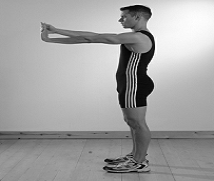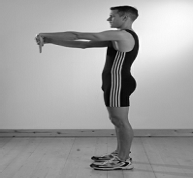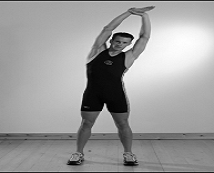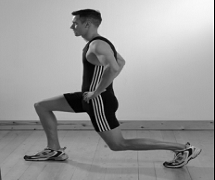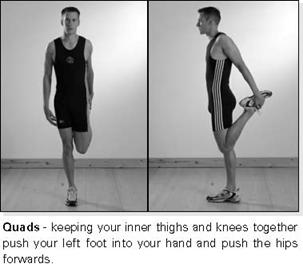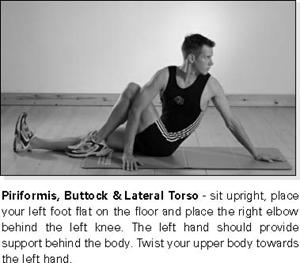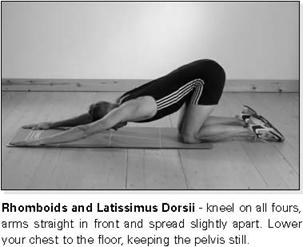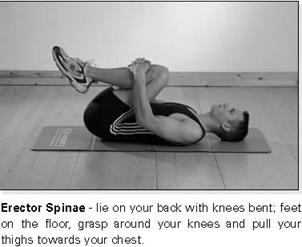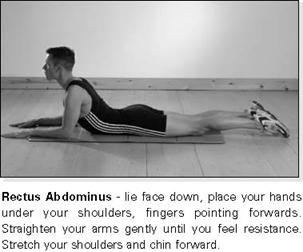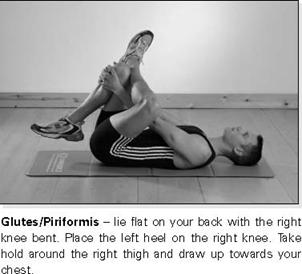


Introduction
Weight training is a form of resistance training, which simply means any kind of exercise in which the Muscles exert force against resistance. Weight training uses weight machines and free weights to apply resistance.
Resistance can also be applied with rubber tubes, another person or even water. One of the greatest advantages of weight training is that resistance can be applied in a measured, progressive fashion. After your strength increases enough to lift three blocks of weight, you add another block.
The development of all round strength is best achieved via circuit training progressing through strength training. Weight training is the most widely used and popular method of increasing strength.
Weight Training Definitions:
The term weight training describes a type of exercise that requires the body’s musculature to move (or attempt to move) against an opposing force, usually presented by dome type of equipment.
Reasons for Weight training:
The main reason exercise scientists now recommend adding resistance training to your exercise program is that, for most of us, nothing in daily life provides adequate stimulation for building and maintaining muscle strength. The benefits of weight training read like an anti-aging potion. Here are some of the reasons you should be sure resistance training is part of your exercise program:
1. Weight training can help to prevent age-associated declines in muscle cell mass and strength
Some of the decline in strength that occurs as we age is inevitable. Studies have shown that people lose about 30 percent of their muscle mass between the ages of 20 and 70. That>s the bad news. However, much of the loss of physical function that occurs is due to inactivity and a consequent decline in physical fitness, rather than aging itself. In <<sedentary> muscles, cells shrink and become weaker. The good news is that strength training enables us to maximize the size and strength of the muscle cells we have, no matter how old we are. Even men and women who begin strength training in their 80s and 90s experience significant strength gains, doubling and even tripling their strength after several months of training.
2. Weight training helps maintain the independence of older adults
When muscle strength declines to a point where we can no longer take out the trash, carry groceries or take the laundry to the basement, we lose the ability to live independently and must increasingly rely on others for help. Weight training can make an important contribution to the quality of life for older men and women.
3. Weight training can prevent age-associated declines in metabolic rate
A decline in muscle mass is one of the main reasons metabolic rate decreases as we age. Metabolic rate is partly a function of how much muscle tissue you have. That>s why bigger people need to eat more. Muscle tissue is metabolically active even when you are not exercising so, even at rest, the more muscle
you have, the more calories you burn. Strength training can help slow the age associated decline in metabolic rate by preserving muscle mass.
4. Weight training helps to prevent orthopedic problems
In our sedentary society, many orthopedic problems are the result of weakness and inflexibility, which are often shrugged off and attributed to the aging process. But many of these aches and pains are not something you have to live with. Neck, back, shoulder, knee and hip pain often respond to physical
therapy treatment that includes strengthening and stretching the affected area. Why wait until you get injured to develop optimal strength and flexibility?
5. Weight training strengthens not only muscles
Weight training strengthens not only muscles, but other structures as well. These include tendons (which attach muscle to bone), ligaments (which con nect bones at joint areas) and joint capsules. Stronger muscles and joints are less prone to injury. Weight training may also increase bone strength by helping
maximize bone mineral deposition in young adults and minimize its loss later in life.
6. Weight training helps you look and feel better
Weight training is the most efficient way to improve muscle definition. Many people who work out only two or three sessions per week will start to see improved muscle tone after only eight or 10 weeks
Benefits of Strength Training:
- Increased muscle fiber size
- Increased muscle contractile strength
- Increased bone strength
- Reduced risk for injury
- Improved ability to perform work or exercise
- Improved body composition
- Increased metabolic rate
.
Safety note: People with health concerns or heart disease risk factors should check with their doctors before beginning a new exercise program.
How to increase strength
A muscle will only strengthen when forced to operate beyond its customary intensity (overload). Overload can be progressed by increasing the:
-resistance e.g. adding lOkg to the barbell
- Number of repetitions with a particular weight
-Number of sets of the exercise
- Intensity, i.e., decrease the amount of recovery time
Weight Training Terminology:
- REPETITION = one complete movement of an exercise. It normally consists of two phases: the concentric muscle action (lifting the resistance) and the eccentric muscle action (lowering of the resistance).
- SET = a group of repetitions performed continuously without stopping. Sets typically range from 1 to 15 repetitions.
- REPETITION MAXIMUM (RM) = the maximum number of repetitions per set that can be performed at a given resistance with proper lifting technique
- POWER = rate of performing work. Power during a repetition is defined as the weight lifted times the vertical distance the weight is lifted divided by the time to complete the repetition. You can increase power by decreasing the time to complete the repetition or by increasing the weight lifted.
- Breathing:
- Exhale concentrically and inhale eccentrically
- Breathe in during exertion and breathe out during lowering
- Only about 1 or 2 sacs of breath holding
- STRENGTH = the maximal amount of force a muscle or muscle group can generate in a specified movement pattern at a specified velocity of movement.
Muscle Hypertrophy:
Muscle Fiber Hypertrophy Resistance training will increase the muscle size (hypertrophy).
Muscle growth depends on the muscle fiber type activated and the pattern of recruitment. Muscle growth is due to one or more of the following adaptations:
- increased contractile proteins (actin & myosin)
- increased number of and size of myofibrils per muscle fiber
- increased amounts of connective, tendinous & ligamentous tissues
- increased enzymes and stored nutrients
Muscle Fibers:
- Slow-twitch fibers
- Fatigue resistant
- Don’t contract as rapidly and forcefully as fast-twitch fibers
- Rely primarily on oxidative energy system
- Fast-twitch fibers
- Contract rapidly and forcefully
- Fatigue more quickly than slow-twitch fibers
- Rely more on nonoxidative energy system
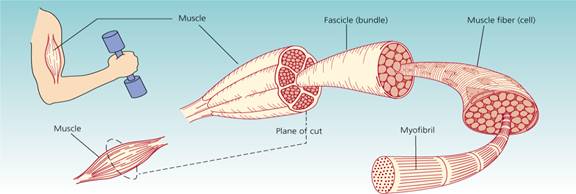
Types of Strength Training:
- Static (isometric) exercise = muscle contraction without a change in the length of the muscle
- Dynamic (isotonic) exercise = muscle contraction with a change in the length of the muscle
- Concentric contraction = muscle applies force as it shortens
- Eccentric contraction = muscle applies force as it lengthens
Factors That Affect Strength Training:
- GENDER. Although male and female muscle tissue is essentially the same, men typically have more muscle than women because the presence of testosterone positively influences muscle size.
- AGE. The rate of strength gains appears to be greater during the years of normal growth and development, generally considered to be from ages 10 to 20 years.
- MUSCLE LENGTH. People with relatively long muscles have a greater potential for developing size and strength than people with relatively short muscles.
- MUSCLE FIBER TYPE. People with a prevalence of fast-twitch muscle fibers may obtain better results from their strength-training program.
Before and After Exercise:
Before you start on your training programme it’s important to understand, the health and
safety procedures involved in weight training. Therefore please take time to read through this section
Carefully. That way you can avoid any unnecessary problems or injuries and get the most out of your programme, both in terms of performance and enjoyment.
Warm Up:
The aim of a warm up is to prepare the athlete both physically and mentally for exercise. When starting
exercise, the body begins to release adrenalin, which increases the heart rate and causes dilation of the
capillaries in the muscles.
- Should gradually increase the heart rate, blood pressure, oxygen consumption, dilation of the blood vessels, elasticity of the active muscles, and the heat produced by the active muscle groups
- Should consist of graduated aerobic activity and flexibility exercises specific to the biomechanical nature of the primary conditioning activity
- The intensity of the warm-up should be well below that of the primary conditioning activity
- a necessity for maximizing safety during strength training workouts.
- Helps prepare the mind and body for the primary physical activity.
Cool Down:
The cool down, like the warm up, is a very important part of each training session and competition. The
purpose of the cool down is maintaining light, continuous exercise to allow your body to pump oxygen
around the fatigued muscles.
- Purpose is to slowly decrease the heart rate and overall metabolism
- Activity used for cool-down should be low-level aerobic exercise, similar to that of the conditioning exercise
- Helps prevent the sudden pooling of blood in the veins and ensures adequate circulation to the skeletal muscles, heart, and brain
- May aid in preventing delayed muscle soreness
- Reduces any tendency toward post-exercise fainting and dizziness.
Stretching:
The stretching that you do in the warm up and cool down has different purposes. In the warm up
stretching allows a slight increase in flexibility that will result in improved performance and reduce the likelihood of injury. In the cool down stretching has the purpose of helping the body to remove some of the buildup of lactic acid in the muscles and to improve flexibility. For these reasons the stretching in the warm up and cool down are of different durations.
Stretching Guidelines
• Regular stretching is important in improving flexibility.
• It takes time to make significant progress with stretching exercises. Start by selecting just a few simple exercises to begin stretching each muscle group.
• Stretching should be done slowly, with no jerking or bouncing movements never stretch to the point of pain.
• In the warm up, after reaching a good stretch position, hold it for eight to 15 seconds. In the cool down this can be increased to 45 to 60 seconds
• The muscle being stretched should be as relaxed as possible. Stretch both sides of the body equally.
• Stretching exercises are not meant to be competitive. Do not compare progress with others as overstretching can lead to injury.
Stretching Exercises:
Warm up/pre-exercise stretches should be held for eight to 15 seconds and should be done two to three times. Cool down/post–exercise stretches should be held for 45 to 60 seconds and should be done two to three times. In a flexibility session each stretch should be held for 45 to 60 seconds and should be repeated three to five times at least. where stretches can be done on both sides of the body only one side is shown. ensure that you stretch both sides equally.
Here are some examples:
 Neck extensors - flex the chin to the chest. Scalenes - facing forwards, bring the ear towards the shoulder taking care not to lift the shoulder. |
|
|
|
|
|
|
|
|
|
|
|
|
|
Choosing equipment:
Weight machines versus free weights, resistance is provided by both types.
- Exercise machines: Safer, convenient, and easy to use
Advantages = safe, less balance required, productivity in a short amount of time, less supervision required, and ideal for circuit training
Disadvantages = lack of development of balance and coordination and constrained movement patterns.
- Free weights: Require more care, balance, and coordination Strength transfers to daily activities
Advantages = balance required which results in better coordination and greater muscle utilization, greater variability, and exercises resemble real-life movements
Disadvantages = requires strength to maintain balance and coordination, accidents are more likely to happen, spotters are required, complete workouts may take more time, and inability to train through the entire range of motion
Applying the FITT Principle:
- Frequency = days per week(American College of Sports Medicine recommends 2-3 days per week allow 1 full day of rest between workouts).
- Intensity = amount of resistance: Choose resistance based on your current fitness level and goals.
- To build strength
- Lift heavy weights (80% of 1 RM)
- Perform a low number of repetitions
- To build endurance
- Lift lighter weights (40-60% of 1 RM)
- Perform a high number of repetitions
- For a general fitness program
- Lift moderate weights (70% of 1 RM)
- Moderate number of repetitions
- Time = number of repetitions and sets
- To build strength and endurance, do enough repetitions to fatigue the muscles
- The heavier the weight, the fewer the repetitions (1-5) to fatigue = a program to build strength
- The lighter the weight, the higher the number of repetitions (15-20) to fatigue = a program to build endurance
- To build both strength and endurance, try to do 8-12 repetitions of most exercises
- Type = strength training exercises for all major muscle groups
- To build strength and endurance, do enough repetitions to fatigue the muscles
- The heavier the weight, the fewer the repetitions (1-5) to fatigue = a program to build strength
- The lighter the weight, the higher the number of repetitions (15-20) to fatigue = a program to build endurance
- To build both strength and endurance, try to do 8-12 repetitions of most exercises
Weight Training Safety:
Be Safe.
Lifting weights can cause serious injury. You can lift weights more safely by following these basic guidelines.
Find an Instructor.
Find someone who can help you learn how to do the exercises correctly. Good technique is most important to avoid injury.
Set Goals.
With your instructor's help, decide on the goals of your weight-training program. These goals will depend on your age, your physical maturity, and the reason you are lifting weights.
Wait until you’re ready.
Wait until your body has matured enough before you try the major lifts
Warm Up and Cool Down.
Warm up and cool down for each session. Warm up before the weight-lifting session with stretching exercises,
DOs
- Do use spotters when you try the major lifts. A spotter is someone who can help you with the weight in case you cannot lift it.
- Do keep your back straight when lifting.
- Do use proper lifting technique when moving weights around the room.
- Do wear shoes with good traction.
- Do make sure the equipment you use is in good condition.
- Do follow all of your gym's safety rules.
DON'Ts
- Don't breathe in and out fast or hold your breath when you lift heavy weights. You may faint and lose control of the weights. Breathe out when you lift or press.
- Don't continue lifting if you feel pain. Stop the painful exercise for a few days or try it with less weight.
- Don't exercise any set of muscles more than three times a week.
- Don't "cheat" on your technique to lift heavy weights.
- Don't lift heavy weights without spotters.
- Don't lift more than you know you can lift safely.



